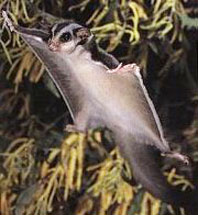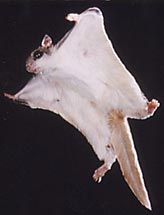Sugar Gliders are quickly becoming one of the most popular pets in the country. In all but four states you can take these furry little flyers home to perform tricks like these for you. But how do they achieve such controlled glides, as seen in the video’s best trick?
A sugar glider’s method of aerial locomotion is extremely similar to an animal we have already seen, the Flying Squirrel. They have a thin membrane that extends from both of their wrists to both of their ankles, called a patgium. When they jump in order to glide, they extend their limbs, stretching the patagium into a rectangular shape (shown below).
The patagium acts like a parachute, greatly increasing the sugar glider’s surface area, which leads to a much larger drag force opposing gravity. This allows a slow, controlled descent. Meanwhile, the glider’s initial jump provides all the horizontal motion it needs for the glide. In the wild, sugar gliders can cover a distance of almost 200 feet in a single glide!

Sugar glider
The sugar glider can also control its direction in few different ways. They can change the curvature or angle of the patagium in order to tilt the body in a desired direction and turn. It is also hypothesized that the sugar glider may use the rotation of its long tail to tilt its body (using conservation of angular momentum), much like the falling gecko.
One thing the sugar glider is not very good at doing in the air is braking. When it is about to land, the glider is able to slightly tilt its body and patagium upwards, which slows it by producing more horizontal drag. However, in order to come to a complete stop in the wild, sugar gliders actually collide into trees (like the gliding ants), and then use their claws to latch on to the trunk.

Flying squirrel
It is remarkable how similar sugar gliders and flying squirrels are, despite being only distantly related. Sugar gliders are marsupials, like kangaroos, while flying squirrels are placental mammals, like humans. Yet natural selection has independently given these creatures analogous structures like the patagium (jumping from trees) and large, cute eyes (because they are nocturnal).
Incidentally, for people looking for exotic pets, flying squirrels can now be found at certain pet stores, alongside those adorable sugar gliders.
References
“Analogy: Squirrels and Sugar Gliders.” Understanding Evolution. Web. 19 Oct. 2011.
Feldman, Ruth Tenzer. “Animal Angles.” Odyssey. Mega Search Plus.
3 Comments
Lorena Barba posted on October 20, 2011 at 2:06 pm
Very nice how you compared with the gecko and gliding ants, and how you pointed out the evolutionary convergence between the sugar glider and flying squirrel.
Lorena Barba posted on October 20, 2011 at 7:12 pm
The video is quite cute. And the glider seems to have pretty good aim!
Stephen Deschamps posted on October 21, 2011 at 11:43 am
Maybe I will get one as a pet now. Thanks for the idea, Hersh.